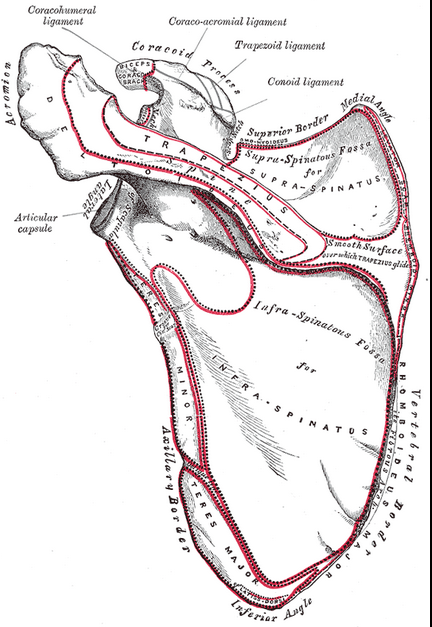My new client came in for a session, reporting shoulder pain, primarily in the front of his deltoid (the muscle at the top of the arm). The pain had started while lifting weights one day and had not gone away, worsening after time spent working on the computer.
He said he suspected it was a rotator cuff issue. After an intake and discussion of other possible causes, we got to work.
We began with treating the pectoral muscles, which were extremely tight (as is common). We also worked the attaching neck muscles, and deep release of the scalenes brought a bit of release to the shoulder joint.
Next, we went to work on the infraspinatus. The infraspinatus is one of the four rotator cuff muscles, and it lies directly on the back of the scapula. A tight, spasming infraspinatus tends to refer pain into the front deltoid, and the front of the shoulder joint (right where the shoulder meets the arm), and I suspected this was the cause of the pain he had complained about.
After releasing the other primary muscles involved, including the supraspinatus, subscapularis, trees minor, and lattisimus dorsi, we moved on to the other large back muscles: mainly, the erector spinae group, which run up and down the back and support the spine; and the quadrates lomborum, which is the large muscle of the low back.
After the session was finished, the client happily reported that the pain was “almost completely gone.” I asked where he still felt pain, and he moved his arm around, noting, “It’s almost hard to find!” He found, however, that there was still a bit of pain in the original spot.
I had him lie on the floor on his back, and I placed a therapy ball (a tennis ball will do) under his scapula, so that his shoulder blade lay right on top of the ball, applying pressure directly to the belly of the infraspinatus. His eyes widened. “That’s exactly the spot!”
His homework, I told him, was using a ball to release that muscle, exactly as we were doing. In many cases, a spasming muscle will refer pain elsewhere. But, once the “culprit” is found, releasing the problem muscle and preventing further pain becomes much easier.
The rotator cuff muscles are not unique in referring pain in this way, but they do seem to do it frequently. Habits such as long work hours at a computer can cause tightness in the rotator cuff muscles that can often be relieved by pressure with a therapy ball/ tennis ball. Stretching can be of value with many muscles, but in the case of the infraspinatus, which lies directly on the scapula, direct pressure is needed.
To release this muscle, lie flat on your back and position a tennis ball or therapy ball directly under the shoulder blade. (This is tricky because it’s a bit of a balancing act). Sink directly into the ball. Most people are tight/ sensitive in this muscle, and you should feel it! If you don’t feel anything, adjust around a bit until you do. (Be sure to stay on the shoulder blade). Once you find “the spot,” sink in as best you can and hold steady pressure for 2-3 minutes. Following this, come off of the ball carefully, sit up and stretch your arms and shoulders. If you’ve gotten into the infraspinatus muscle, you will likely feel a bit more range of motion just from doing this exercise.
Questions about this muscle and related pain? Email me at rachel@rachelhardy.com, or book a session here if you’d like do some work on releasing the muscles in the shoulder area.
Take care of yourself and your muscles! They’re working hard for you.



